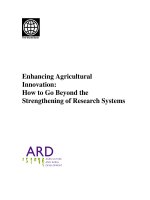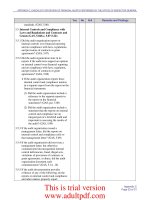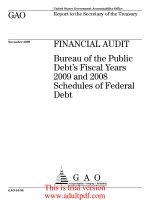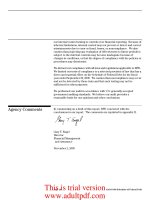21st Century Welfare: Presented to Parliament by the Secretary of State for Work and Pensions by Command of Her Majesty pptx
Bạn đang xem bản rút gọn của tài liệu. Xem và tải ngay bản đầy đủ của tài liệu tại đây (1.99 MB, 52 trang )
Presented to Parliament by the Secretary of State
for Work and Pensions by Command of Her Majesty
July 2010
Cm 7 9 1 3. £14.75
21
st
Century Welfare.
21
st
Century Welfare.
Presented to Parliament by the Secretary of State
for Work and Pensions by Command of Her Majesty
July 2010.
Cm 7 9 1 3. £14.75
© Crown Copyright 2010.
The text in this document (excluding the Royal Arms and other
departmental or agency logos) may be reproduced free of charge in
any format or medium providing it is reproduced accurately and not
used in a misleading context. The material must be acknowledged
as Crown copyright and the title of the document specified.
Where we have identified any third party copyright material you will
need to obtain permission from the copyright holders concerned.
ISBN: 9 7 8 0 1 0 1 7 9 1 3 2 8.
Printed in the UK for The Stationery Office Limited
on behalf of the Controller of Her Majesty’s Stationery Office.
ID: 2 3 8 0 0 9 1 07/10.
Printed on paper containing 75% recycled fibre content minimum.
This publication can be accessed online at:
www.dwp.gov.uk/21st-century-welfare
For more information about this publication, contact:
Benefit Reform Division
Department for Work and Pensions
1st Floor
Caxton House
Tothill Street
London
SW1H 9NA
Tel: 0 2 0 7 4 4 9 7 6 8 8
Email: benefi
Copies of this publication can be made available in alternative formats if required.
Contents.
Foreword by the Secretary of State 1.
Executive summary 2.
Chapter 1
Introduction 4.
Chapter 2
Problems with the current system 7.
Chapter 3
Principles and options for reform 17.
Chapter 4
Other areas of reform 27.
Chapter 5
Delivery of a reformed system 32.
Chapter 6
Conclusion 38.
Chapter 7
Questions 40.
Annex Seeking views 42.
List of figures.
Figure 1
Benefits, Tax Credits and earnings 12.
Figure 2
Universal Credit – outline structure 20.
Figure 3
The Single Unified Taper 23.
Figure 4
Conditionality 28.
Figure 5
A real-time payment system 35.
21
st
Century Welfare 1
Foreword by the Secretary of State
After less than three months of innovative Coalition Government, we want to begin real
change to the benefits system by making it simpler and more efficient, with a view to
fewer benefits, fewer layers of bureaucracy and with financial support firmly focused
on making work pay. Less than one year ago, I said that unless politicians and civil
servants acted to reform our complicated and inefficient benefits system, then further
talk about work being the best route out of poverty would be more empty rhetoric.
Too often governments have tried to tackle poverty but ended up managing its
symptoms. The changes outlined here are based on a recognition that poverty
cannot be tackled through treating the symptoms alone.
The benefits system has shaped the decisions of the poorest in a way that has trapped
generation after generation in a spiral of dependency and poverty. This has cost the
country billions of pounds every year in cash payments and billions more in meeting
the social costs of this failure.
The only way to make a sustainable difference is by tackling the root causes of poverty:
family breakdown; educational failure; drug and alcohol addiction; severe personal
indebtedness; and economic dependency.
These problems are interrelated and their solutions lie in society as a whole. However,
we must recognise that the benefits system has an important role to play in supporting
personal responsibility and helping to mend social ills.
We are going to end the culture of worklessness and dependency that has done so
much harm to individuals, families and whole communities. Our aim is to change
forever a system that has too often undermined work and the aspiration that goes
with it.
By actively putting work at the centre of working-age support we want to create a
new contract with the British people, which is why we are consulting them in this paper.
We will help them to find work and make sure work pays when they do. They in return
will be expected to seek work and take work when it is available. No longer will we
leave people for years on long-term benefits without contact or support. This contract
is about a responsible society working together to improve the quality of life for those
who are worst off.
The Rt Hon
Iain Duncan Smith MP
Secretary of State for Work and Pensions
2 Executive summary
1. The benefits system as it stands often provides incentives to stay on benefits
rather than take on a job. We want to support people to move into and progress
in work, while still supporting those in greatest need.
2. The Budget outlined the first steps in achieving these goals. However, the scale
of the Government’s ambition in this area warrants the consideration of more
fundamental structural reforms. This paper identifies the key failings of the
benefits system and outlines the objectives we believe the system should
attempt to achieve. We then focus on how we might seek to address these
failings and outline some key issues we will need to work through to deliver
a benefits system for the 21
st
Century.
3. The framework we are considering greatly improves on earlier reforms because
it looks at the system of state support for the less well off as a whole and is
designed to produce positive behavioural effects. We want to maximise work
incentives while continuing to protect those most in need.
4. This discussion document outlines illustrative examples of structural reform,
including options presented by external organisations.
5. Such structural reforms could enable us to deliver some fundamental changes
to ensure that work always pays and is clearly seen to pay. We could achieve this
through new rules on how much of their earnings people can keep without losing
benefit and by withdrawing benefit as earnings rise at a single, reasonable, rate.
This would mean that people taking the first steps into employment through a few
hours of work each week would see substantial rewards for their efforts. It would
also make the system much simpler.
Executive summary.
21
st
Century Welfare 3
6. We do not aim to reduce the levels of support for people in the most vulnerable
circumstances but it is clearly important that we ensure support is well targeted,
is fair to those on low pay and that the right money goes to the right people.
7. Finally, we are looking at how we could use smart automation to deliver support
without the wasteful bureaucratic delays to payment that make the move
into work more stressful than it needs to be. Similar technologies are already
commonplace in the private sector and should make the benefits system quicker
and more responsive for the customer and more efficient for the taxpayer whilst
not increasing costs to business.
8. Our ideas would be consistent with possible steps to make aspects of the
welfare system more localised. We will also be looking at individual measures
for increasing work incentives and reducing the extent and costs of welfare
dependency alongside consideration of reform of the structure of the system.
9. Subject to the outcome of this consultation, we hope to bring forward legislation
early in the New Year to reform the benefits and Tax Credits system to make work
pay. We would welcome views on how best to design such a system so as to meet
our proposed principles and as part of our duties to have due regard to equality.
4 Chapter 1 Introduction
1
Introduction.
1. We said at the outset of this Government that we would investigate how
to simplify the benefits system in order to improve incentives to work. This
commitment was restated in the Queen’s Speech and the Budget. The Budget
also set out the first steps in trying to achieve these aims. However, the
Government wants to go further to improve incentives and reduce welfare
dependency. This discussion document takes that work forward.
2. It is clear that, in common with other countries, we need to address the high
and increasing costs of welfare dependency. There are now nearly five million
working-age people receiving the main out-of-work benefits.
1
However,
worklessness is not just the result of the recession – 1.4 million people have
been receiving out-of-work benefits for nine or more of the last ten years.
2
Almost two million children are growing up in households where no-one is in work.
3. Successive governments have made well-intentioned but piecemeal reforms
to the system. None have succeeded in tackling the fundamental structural
problems that undermine personal responsibility and the effectiveness of welfare.
They have left in place a hugely complex set of interdependent benefits and Tax
Credits delivered by numerous different agencies.
4. Too many people believe they are better off on benefits than in work.
3
Existing in-work support means that most should get more income when
they work, but the gains for many are marginal and incentives are undermined
by the need to navigate through the maze of in-work and out-of-work benefits
and their interactions.
1 Latest Jobseeker’s Allowance Claimant Count figures are available via the Office of National Statistics’ Labour
Market Statistics; Early estimates for Working Age Inactive Benefit Client Groups, and Benefit Caseload National
Statistics are available via the Department for Work and Pensions’ Tabulation Tool.
2 Department for Work and Pensions Longitudinal Study (the figure is for people claiming Income Support,
incapacity benefits and Jobseeker’s Allowance).
3 Examples of the concerns people have about managing financially when moving into a job can be found in
Woodland S, Mandy W and Miller M, 2003, Easing the transition into work (Part 2: client survey), Department for
Work and Pensions Research Report No 186.
21
st
Century Welfare 5
5. For example, in about 450,000 cases, Tax Credits awarded by HM Revenue &
Customs are taken into account as income by the Local Authority in assessing
Housing Benefit. The system gives with the one hand, only to take away with
the other.
6. In short, the overly bureaucratic benefits system can act as a barrier to work,
trapping people in poverty.
Affordability
7. Demographic changes mean that the cost of the welfare system is predicted to
rise at a time when we can least afford it. We started to address this through the
measures announced in the Budget, in particular the changes to the uprating of
benefits, Disability Living Allowance and Housing Benefit. These reforms, along
with reforms to obligations placed on out-of-work lone parents, build on a wealth
of evidence that highlights the role of a strong system of conditionality in helping
those dependent on benefits move into paid work.
8. The next step is to tackle the cost of the system by supporting many more people
into work. Alongside the introduction of the Work Programme, we believe there
is a strong case for reforming the system as a whole, addressing the root causes
of the problems we face.
Rewarding work and personal responsibility
9. The experience from previous attempts at piecemeal reform suggest that it is
unlikely that the full extent of the Government’s ambition can be delivered without
a more fundamental structural approach. By integrating and reforming the current
income-related benefits and Tax Credits systems we could ensure that:
• householdsandfamiliesseethegainsfromincreasingtheamountofpaid
work they do because they would keep more of their earnings;
• afairbalanceisstruckbetweensupportandconditionality,makingclearthat
we will not accept a culture of dependency nor will anyone be written off; and
• positivebehaviours,suchassavingforretirementorbuyingyourownhome,
are rewarded rather than penalised.
Reduced worklessness
10. We want to allow more people to do some paid work, and then to remain in work
and increase their earnings. Getting the balance between these two elements
will be crucially important. We also want to remove the fear that the system will
punish them for doing so.
11. We would not propose to force people who are not able to work, or prepare for
work, to do so. Support for people in the most vulnerable circumstances would
remain unconditional.
6 Chapter 1 Introduction
A fair system that protects those in greatest need
12. Any reforms should also:
• establishafairerrelationshipbetweenthepeoplewhoreceivebenets
and the people who pay for them and, as crucially, between the people
on out-of-work benefits and the people who work in low-paid jobs;
• targetsupportmoreefciently,supportingandprotectingthoseinvulnerable
circumstances;
• helptodivertpeopleawayfromthepathwaysthatleadtopovertyandgive
people living in poverty a route out; and
• supportourwidergoalofstrengtheningfamilies,supportingcarersandenabling
disabled people to have an equal role in society.
A simpler system
13. The ideas for reform, discussed in this paper, would make it is easier for individuals
to understand what they are entitled to, easier for people to make or change a
claim and easier for them to understand how any changes in their circumstances
will affect their claim.
Less delay, reduced error and fraud
14. The modern economy moves and changes quickly. Modern government should
support people to be flexible in taking work, but the current benefits system is too
cumbersome to do this effectively, creating delays to payments that discourage
people from moving into work as and when the opportunities arise. Overpayments
and subsequent repayments can also create serious cash-flow problems, making
it even more difficult for them to manage their finances.
15. A simpler and fairer system could assess and pay benefits faster and could
reduce the scope for error and fraud: claimants would more clearly understand
what they are entitled to and would have less bureaucracy to deal with,
while people who administer the system would be less likely to make errors.
16. A more modern automated payments system would bring public services
into line with the standards we all expect of our banks. It would also allow
people to be more flexible in taking on temporary work as they could be sure
that support would be delivered as and when necessary without undue delay.
Conclusion
17. Work and personal responsibility must be at the heart of the new benefits system.
This should provide support backed up by a strong system of conditionality that
makes clear what is expected of claimants in return for the support they receive.
In the next chapter, we consider in more depth the problems of the current system.
21
st
Century Welfare 7
2
Problems with the
current system.
Summary
Our welfare system has failed to keep up with the pace of change in the economy
and society. Successive governments have made piecemeal reforms without
rationalising the overall landscape.
There are two key problems.
1. Work incentives for some groups are poor:
• interactionsbetweenbenetsandTaxCreditsmakethetransition
to work risky and uncertain;
• thenancialincentivestoenterworkatlessthan16hoursare
relatively low: this works against the successes of the strong
conditionality regime; and
• therateatwhichbenetsandTaxCreditsarewithdrawnas
earnings increase means that some people see no more than a
few pence for every extra £1 earned – resulting in the perception
that work does not pay.
2. The system is too complex:
• forclaimants–arisingfromtheinteractionbetweendifferentbenets
and Tax Credits and layers of previous reforms, with many different
benefits addressing the same underlying issue and entitlement to
benefit paid by one agency affecting the benefit payable by another; and
• toadminister–wherepeoplemayneedtoprovidethesameinformation
to different agencies, often through paper-based transactions.
As a result we have rising costs of state support – including waste through
unproductive administration, error and fraud – accompanied by high rates of welfare
dependency and poverty.
8 Chapter 2 Problems with the current system
1. The benefits system has evolved with good intentions but with flawed results.
Successive governments have tinkered with bits of the system but have failed
substantially to address:
• risingcostsofstatesupport;
• highratesofwelfaredependencyandpoverty;and
• astructureandsetofrulesthatcandrivenegativeratherthan
positive behaviours.
2. The situation stems from two key underlying problems:
• workincentivescanbepoor;and
• thesystemistoocomplex.
Rising costs of state support
3. The costs of maintaining a failing system are spiralling out of control; we cannot
continue spending at such a rate on welfare that all too often has a negative rather
than a positive impact. In the last decade, spending on working-age benefits and
Tax Credits rose from £63 billion in 1996/97 to £87 billion in 2009/10 (in real terms,
2010/11 prices).
4
4. Multiple agencies use valuable resources to gather and manage largely the same
information in very similar ways. The Department for Work and Pensions and
its agencies spend around £2 billion a year to administer and pay working-age
benefits, Local Authorities spend a further £1 billion to administer Housing
Benefit and Council Tax Benefit and HM Revenue & Customs spends more than
£500 million a year.
5. Overpayments hit the poorest hardest, while error and fraud is estimated to
cost the taxpayer around £5.2 billion a year: £2.1 billion in Tax Credits (around
8.9 per cent of entitlement in 2008/09)
5
and £3.1 billion in Department for Work
and Pensions benefits (around 2.1 per cent in 2009/10).
6
Underpayments are also
a problem, leaving customers without entitlements estimated at £1.3 billion a
year in benefits and £260 million a year in Tax Credits.
7
4 Department for Work and Pensions expenditure data.
5 HM Revenue & Customs, 2010, Child and Working Tax Credits Error and Fraud Statistics 2008-09:
www.hmrc.gov.uk/stats/personal-tax-credits/cwtcredits-error0809.pdf
6 Department for Work and Pensions, Fraud and Error in the Benefit System: October 2008 to September 2009.
7 HM Revenue & Customs, 2010, Child and Working Tax Credits Error and Fraud Statistics 2008-09:
www.hmrc.gov.uk/stats/personal-tax-credits/cwtcredits-error0809.pdf
21
st
Century Welfare 9
6. As we noted in chapter 1, the cost of welfare is rising at a time when we can least
afford it. The Budget announced a number of changes to existing benefits to curb
rises in expenditure and to make the system fairer. Other countries are similarly
considering their social security spending as public finances deteriorate. For
example, the Irish government has reduced expenditure on social insurance and
social assistance schemes through percentage reductions in benefit payments and
tightening entitlement criteria for certain benefits. In Iceland, austerity measures
include freezing welfare benefits for two years. In the UK we are considering
further targeted reforms as part of the Spending Review.
High rates of welfare dependency and poverty
7. Welfare dependency has become a significant and growing problem in Britain,
with huge social and economic cost for both claimants and wider society.
The welfare state is now a vast, sprawling bureaucracy that can act to entrench,
rather than solve, the problems of poverty and social exclusion.
8. 12 million working-age households receive benefits and Tax Credits costing
more than £85 billion a year.
8
• Morethanoneinfourworking-ageadultsintheUKdonotworkand
2.6 million people have spent at least half of the last 10 years on some
form of out-of-work benefit.
9
• Aroundafthoffamilieswithchildrenareinpovertyatanyonetime,and
around two-fifths experience poverty at some time in a three year period.
10
• 35percentoffamiliesremaininpovertywhenaparententerswork
11
yet
2.4 million households now receive Working Tax Credit.
12
9. The welfare system has failed to tackle intergenerational disadvantage and poverty.
For example, a higher proportion of children grow up in a workless household in the
UK than in almost any other EU country
13
and the risk of poverty is higher for those
who are poor as children or teenagers.
14
Question 1
What steps should the Government consider to reduce the cost of the
welfare system and reduce welfare dependency and poverty?
8 Cabinet Office, 2010, State of the Nation report: Poverty, worklessness and welfare dependency in the UK,
HM Government ref 401172/0510.
9 Ibid.
10 Browne J and Paull G, 2010, Parents’ work entry, progression and retention and child poverty, Department
for Work and Pensions Research Report No. 626.
11 Ibid.
12 HM Revenue & Customs, April 2010, Child and Working Tax Credits Statistics, Office of National Statistics
13 Eurostat, 2008 data.
14 Blanden J and Gibbons S, 2006, The persistence of poverty across generations: A view from two British
cohorts, Report for the Joseph Rowntree Foundation, Bristol: Policy Press.
10 Chapter 2 Problems with the current system
Failure of the current system to generate
positive behavioural effects
10. The current benefits system gives little consideration to the behaviours it
generates. Complexity and poor financial incentives to work are a key factor in
trapping people in worklessness. This is strongly linked with poverty and reduced
well-being, poorer physical and mental health and an increased likelihood of
becoming involved in the Criminal Justice System. Previous changes have failed
to address the impact of benefits on these issues. Where parents have multiple
disadvantages (such as low income, poor health, no qualifications), their children
are also likely to experience disadvantage themselves.
15
Work incentives can be poor
11. The current benefits and Tax Credits system influences financial work
incentives through:
• earningsdisregards–theamountpeoplecanearnwithoutitaffecting
their benefit;
• additionalpaymentsforpeopleworkingatleast16or30hoursthrough
Tax Credits; and
• taperedwithdrawal–therateatwhichearningsinexcessofadisregard
are deducted from benefit.
12. This system currently leaves some groups facing poor work incentives.
These include lone parents who work less than 16 hours a week and young
people for whom Working Tax Credit is not available.
13. People working fewer than 16 hours a week can continue to be eligible for
out-of-work benefits but, for many claimants, there is little gain as every
penny of earnings over a small disregard is lost. It is not surprising, therefore,
that very few people on these benefits are doing any work at all.
16, 17
.
14. Working Tax Credit provides support for people on low wages, but an
individual or couple must satisfy the minimum-hours rules in order to
qualify. The upshot is a system that can trap people into certain hours of
work: they lose disproportionately if they work a few hours less and gain
little by working more.
15 Cabinet Office, 2010, State of the Nation report: Poverty, worklessness and welfare dependency in the UK,
HM Government ref 401172/0510.
16 Department for Work and Pensions Longitudinal Study.
17 This does not apply to Employment and Support Allowance claimants who can in some circumstances
keep £93 a week in earnings and all of their benefit, including (since April 2010) Housing Benefit and
Council Tax Benefit.
21
st
Century Welfare 11
15. The introduction of Tax Credits improved work incentives for some groups but
the picture is still patchy. The Institute for Fiscal Studies
18
has long pointed to
the problems with work incentives in the current system while evidence from
the Citizens Advice service shows the negative impact the benefits system has
on lone parents.
19
16. It is estimated that in total, more than 600,000 people could face a Participation
Tax Rate
20, 21
in excess of 90 per cent – that is more than 90 per cent of their gross
earnings are lost through tax and withdrawn benefits. This measure does not
take account of in-work costs such as travel, which can easily wipe out a meagre
financial gain.
17. Table 1 below shows the number of people facing Marginal Deduction Rates
22
of different degrees of severity – it shows for instance that 130,000 people face
a Marginal Deduction Rate over 90 per cent who would gain 10p or less from a
£1 increase in their pay because of the amounts lost through tax and withdrawal
of benefits and Tax Credits.
Table 1
Marginal Deduction Rates
23
2011-12
Over 90 per cent 130,000
Over 80 per cent 330,000
Over 70 per cent 1,710,000
Over 60 per cent 1,935,000
Marginal Deduction Rate figures shown are for working heads of families in receipt of income-related benefits or
Tax Credits where at least one person works 16 hours or more a week, and the head of the family is not receiving
pensioner or disability premiums.
18. Figure 1 shows the complex way that benefits and Tax Credits interact with
earnings to produce an overall household income. The way that benefits and tax
credits are withdrawn as income rises combines with increased income tax and
NI contributions to produce high Marginal Deduction Rates in some cases. In this
example, based on current benefit and tax rates, a couple with a single earner
and two children sees a Marginal Deduction Rate of 95.5 per cent
24
on earnings
between £126 and £218. This means that someone at the National Minimum Wage
would be less than £7 per week better off if they worked 16 extra hours and earned
an extra £92 (an effective wage rate of 44p per hour). A system that produces this
result cannot be right.
18 Adam, A. Brewer, M. and Shephard, A., 2006, Financial Work Incentives in Britain: Comparisons over time and between
Family Types, IFS WP 06/20.
19 Citizens Advice, October 2008, Citizens Advice Evidence Briefing: Barriers to work: Lone parents and the challenges
of working.
20 Participation Tax Rate – the proportion of gross earnings lost in tax and withdrawn benefits.
21 This figure was calculated using the Department’s Policy Simulation Model, which is based on the 2007/08 Family
Resources Survey and includes the tax and benefit policies announced in the June 2010 Budget. Those modelled
as moving into work are assumed to do so at 25 hours at the minimum wage.
22 Marginal Deduction Rate – the proportion of an additional £1 in income lost in increased income tax and
NI contributions and in reduced benefit and Tax Credit payments.
23 HM Treasury, June 2010, Budget 2010. The table shows people working over 16 hours a week and receiving
income-related benefits or Tax Credits.
24 The changes in the June 2010 Budget will increase the maximum Marginal Deduction Rate to 95.95 per cent.
12 Chapter 2 Problems with the current system
19. Leaving the security of the benefits system is made harder by uncertainty about
how to get benefits reinstated quickly if the job does not work out. Distinct in-work
benefits have failed to convince some people to make the transition to work.
People often worry about the loss of Housing Benefit when they are thinking
of returning to work, or are concerned that their Working Tax Credit may not
be accurate or paid quickly enough.
25
.
20. People planning a move into work have understandable concerns about how they
will support their families during the transition. They ask themselves: “Will the
in-work benefits kick in quickly enough to fill the gap before my pay arrives?”
and “How long will it take to get out-of-work benefits again if the job does not
work out?”.
25 Gloster, R et al, 2010, Lone Parent Obligations: Early findings of implementation as well as experiences of the Income
Support and Jobseeker’s Allowance regimes. Department for Work and Pensions Research Report No. 645.
21
st
Century Welfare 13
21. The complexity of the system means that these legitimate questions can be
difficult to answer. The fear and uncertainty that people experience when thinking
about returning to work is real and understandable. For many, the world of work
is an unknown that raises feelings of apprehension. Underpinning their fears is
the perception that the rewards from working are small, leaving people feeling
that they are being punished for working while their neighbours are rewarded for
doing nothing.
22. As a result, working legitimately is not a rational choice for many poor people to
make. Fraud is always wrong, but we must recognise that the benefits system is
making matters worse by pushing valuable work, and the aspiration that this can
engender, underground.
26
Box 1 Case study: weak work incentives in the current system
Ms A, a lone parent with three school-age children, earns £7.50 an hour as an
office administrator. She is working 23 hours a week, which gives her a net
weekly income (including benefits and Tax Credits) of £345 after paying rent and
Council Tax. She has been offered the opportunity to work for 34 hours a week.
However, this extra effort would only give her about £10 more, so she has very
little incentive to take on the extra work.
Question 2
Which aspects of the current benefits and Tax Credits system in particular
lead to the widely held view that work does not pay for benefit recipients?
The system is too complex
23. The complexity of the system is also a barrier in itself. Successive attempts to
adapt the benefits system to meet immediate priorities have resulted in layer
upon layer of ill-fitting changes, often with long periods of transitional protection,
adding steadily to the complexity.
24. There are three basic income-maintenance benefits for people who are out
of work: Jobseeker’s Allowance, Employment and Support Allowance (replacing
Incapacity Benefit) and Income Support, all paid by the Department for Work and
Pensions and often providing the same level of financial support. These benefits
combine with Housing Benefit, Council Tax Benefit, Child Tax Credit and – for people
moving into work – Working Tax Credit to create an elaborate and confusing tangle
of support. Added to this are contributory and universal benefits which create
further benefit interactions.
26 Barbour A, 2008, Work Incentives in the benefits system: Increasing levels of Earnings Disregard, Community links
Evidence No. 12; SPARK Research, 2004, A Review of the DWP Benefit Fraud Sanctions Regime, Department for
Work and Pensions In-house report.
14 Chapter 2 Problems with the current system
25. This complexity is inefficient, with customers having to go through multiple
application processes with different thresholds, rules and payment periods.
It also increases the risk of error, creates opportunities for fraud and puts
decisions on benefit expenditure beyond effective democratic scrutiny.
27
26. The overlaps in what people can receive are significant. People can get support
from different benefits and different benefits support the same needs. A lone
parent with a young child, for example, might be receiving Income Support, Child
Benefit, Child Tax Credit, Housing Benefit, Council Tax Benefit and a series of other
‘passported’ benefits, each with their own eligibility criteria and rules.
27. Many people have to deal with more than one agency. Nearly half of the six
million people getting benefits from the Department for Work and Pensions also
get Housing Benefit from a Local Authority. Around 1.6 million people receive a
Department for Work and Pensions benefit and some Tax Credits from HM Revenue
& Customs. About a third of Housing Benefit claimants also receive Tax Credits
and have to deal with both HM Revenue & Customs and their Local Authority.
This includes virtually all families with children on Housing Benefit.
28. Research shows that this complexity makes it difficult for people to know what
benefits and Tax Credits they can get. Sometimes people are overpaid Tax Credits
and have to return money later. Complexity undermines trust in the system and
stops customers focusing on getting back to work.
28
People may fail to take up
their entitlements. The transition between benefits and work can also cause
severe financial hardship and emotional stress.
29
People from ethnic minority
groups are more likely to have English as their second language and so may
have particular difficulty with benefit complexity.
30
Box 2 Case study: transitions between benefits
Mr B is claiming Jobseeker’s Allowance. After suffering an accident, he loses
entitlement to Jobseeker’s Allowance because his work capability is limited.
He needs to claim the Employment and Support Allowance to continue to
receive financial support. Any delay in making this claim could mean that he
loses money and he could also lose support for his rent and Council Tax. It can
take Jobcentre Plus a week or two to sort out Mr B’s Employment and Support
Allowance claim, during which time he may need to claim a Social Fund Crisis
Loan to pay for food and other living expenses. After three months, Mr B has
recovered enough to start looking for work again. His Employment and Support
Allowance then ends and he has to claim Jobseeker’s Allowance again.
Question 3
To what extent is the complexity of the system deterring some people from
moving into work?
27 Martin, D, 2009, Benefit simplification: How, and why, it must be done, Centre for Policy Studies.
28 Community Links, Low Incomes Tax Reform Group, CPAG, 2007, Interact: benefits, Tax Credits and moving into
work; (2010) Royston, S, 2007, Benefit simplification and the customer, Department for Work and Pensions paper
www.dwp.gov.uk/docs/simplification-and-the-customer.pdf; Sainsbury R and Weston K, 2010, Exploratory qualitative
research on the ‘Single Working Age Benefit’.
29 Department for Work and Pensions Customer Insight evidence, 2010, Single Working Age Benefit findings,
www.dwp.gov.uk/docs/customer-insight-single-working-age-benefit.pdf
30 Disability Alliance (2003), Out of Sight – Race Inequality in the benefit system.
21
st
Century Welfare 15
Complexity in delivery
“The Department for Work and Pensions issues a total of 14 manuals, with a
total of 8,690 pages, to its decision makers to help them to apply Department
for Work and Pensions benefit rules correctly. A separate set of four volumes
totalling over 1,200 pages covers Housing and Council Tax Benefits, which are
primarily the responsibility of local authorities. The Tax Credits manual used by
HM Revenue & Customs is a further 260 pages, even though it omits details for
many relevant tax concepts which are found in other tax manuals. In addition
to these encyclopaedic works is a cornucopia of circulars, news releases and
guidance notes issued to professionals and claimants. The underlying legal
statutes and statutory instruments make up a vast mass of further material.”
(from David Martin, Benefit Simplification: How, and why, it must be done
31
).
29. Given the range of benefits and agencies, it is hardly surprising that delivery is
also fragmented and complex, requiring customers to make multiple contacts
with different organisations. Applying for, varying or leaving benefits still requires
too much paperwork from too many different government agencies and too much
unproductive time dealing with officials either face-to-face or on the phone.
30. Customers may be required to communicate changes of circumstance separately
to Jobcentre Plus, the Pension, Disability and Carers Service, the Local Authority
and HM Revenue & Customs so that adjustments can be made to payments they
receive. In many circumstances, the same information is requested several times
over. This increases the number of unnecessary customer contacts, at a cost to
both the customer and the taxpayer, and creates potential for error and fraud.
31. When people do move into work, delays in payment can occur as claims stop
and start and entitlement is reassessed. This can affect crucial support, including
in-work Housing Benefit and Council Tax Benefit. A significant number of people
each year transfer between Jobseeker’s Allowance and incapacity benefits alone,
even though the claim is with the same agency.
32. Delays in awarding or reassessing entitlement cause negative experiences of the
general service.
32, 33
The resulting overpayments (and subsequent repayments)
can affect those least able to cope with fluctuations in their relatively low levels
of household income which can create stress and mistrust of the system.
Question 4
To what extent is structural reform needed to deliver customer service
improvements, drive down administration costs and cut the levels of
error, overpayments and fraud?
31 Martin, D, 2009, Benefit Simplification: How, and why, it must be done, Centre for Policy Studies.
32 Gloster, R et al, 2010, Lone Parent Obligations: Early findings of implementation as well as experiences of the
Income Support and Jobseeker’s Allowance regimes. Department for Work and Pensions Research Report 645.
33 Department for Work and Pensions Customer Insight evidence, 2010, Well enough to work findings,
www.dwp.gov.uk/docs/customer-insight-well-enough-to-work.pdf.
16 Chapter 2 Problems with the current system
Conclusion
33. The Government has strong ambitions for the benefit system. The current
problems and experience from previous reforms suggest that structural reform
of the benefits and Tax Credits system as a whole may be needed to address
the key problems of work incentives and complexity. In the next chapter we
look at how we might do this and outline a set of principles to guide reform.
In addition, there are complex interactions with other forms of welfare support
for basic needs (for example, the financing of affordable housing provision and
sub-market rents) and different options for delivery of a reformed system.
Chapters 4 and 5 explore these.
21
st
Century Welfare 17
3
Principles and
options for reform.
Summary
We have set out seven principles for reform which could guide the detailed design
of the system.
This chapter outlines illustrative examples of how structural reform might look,
including options presented by external organisations.
While they do it in different ways, these models all ensure that clearer gains are
available as individuals move into and progress in work, and attempt to ensure
that dependency is reduced in the longer term in order to improve the affordability
of the system.
More work will also be needed to ensure that the specific design issues outlined
are addressed, and that the relative costs and benefits of different reform options
are assessed.
18 Chapter 3 Principles and options for reform
Principles for reform
1. We would propose to use a set of principles to guide reform. They could be to:
• ensurethatpeoplecanseethattheclearrewardsfromtakingalltypes
of work outweigh the risks;
• furtherincentiviseandencouragehouseholdsandfamiliestomoveinto
work and to increase the amount of work they do, by improving the rewards
from work at low earnings, and helping them keep more of their earnings as
they work harder;
• increasefairnessbetweendifferentgroupsofbenetrecipientsandbetween
recipients and the taxpayer;
• continuetosupportthosemostinneedandreducethenumbersofworkless
households and children in poverty and ensure that interactions with other
systems of support for basic needs are considered;
• promoteresponsibilityandpositivebehaviour,doingmoretorewardsaving,
strengthening the family and, in tandem with improving incentives, reinforcing
conditionality;
• automateprocessesandmaximiseselfservice,toreducethescopeforfraud,
error and overpayments. This could include a responsive and immediate service
that saves the taxpayer significant amounts of money and ensures compliance
costs for employers, at worst, no worse than under the current system; and
• ensurethatthebenetsandTaxCreditssystemisaffordableintheshortand
longer term.
Question 5
Has the Government identified the right set of principles to use to
guide reform?
A simpler system with improved work incentives
2. In order to put our principles into practice it is essential to improve work incentives.
Different approaches could be designed to give greater emphasis to either
increasing the incentive to take up work, or to increasing the incentive to increase
earnings once in work. Striking a balance between these elements will be important.
3. With this in mind, there are two key areas where structural reform of the system
could focus: firstly, the number and types of benefits and Tax Credits available
should be considered; and secondly the way in which entitlements are withdrawn
as individuals move into and progress in work could be adjusted.
4. The models outlined below consider these areas, and demonstrate the range of
choices that structural reform would need to consider. Chapter 5 considers how
reform of welfare delivery could also deliver improvements to the system.
21
st
Century Welfare 19
A Universal Credit
5. A Universal Credit would be a new approach to supporting working-age
households. It represents a move towards a system that brings together existing
income-related out-of-work benefits and Tax Credits into a simpler, integrated
system that supports people in and out of work. This builds on recommendations
from a number of organisations from across the social policy field.
34
It would:
• combineelementsofthecurrentincome-relatedbenetsandTax
Credits systems;
• bringout-of-workandin-worksupporttogetherinasinglesystem;and
• supplementhouseholdearningsthroughcreditpayments,reecting
circumstances (including children, housing and disability).
6. Such a structure would remove much of the complexity that burdens the system
today. Crucially it would also create the platform for tackling the current problems
of high Marginal Deduction Rates and low gains to work through reform of earnings
disregards and tapers.
Box 3 How might a Universal Credit work?
• What would I get if I was out of work? The family’s gross entitlement
would depend on their circumstances. Entitlements would be based on
current benefit and Tax Credit rules, with amounts for individuals, couples,
children, housing, disability or caring. The total would then be reduced for
earnings and other income to produce the net amount payable. The credit
would be payable to the household member making the application.
• How would Universal Credit support me to move into and progress in work?
Household members would be incentivised to enter work by a consistent,
reasonable, rate of withdrawal of the Universal Credit as earnings increase.
The incentive would be reinforced through a system of disregards, which
would leave Universal Credit payments unaffected by the first few hours
of earnings.
• What would happen to Tax Credits? A Universal Credit would subsume Tax
Credits as the form of income top-up for families on low earnings, including
support for childcare.
• How would this be delivered? Universal Credit would be delivered through
a new system which would use up-to-date earnings information from
employers to calculate Universal Credit on a household basis – see chapter 5.
• What would happen to the Work Capability Assessment? This would still
be needed to assess applications from customers unable to work through
sickness or disability.
34 Martin D, 2009, Benefit Simplification: How and why it must be done, Centre for Policy Studies;
Centre for Social Justice, 2009, Dynamic Benefits: Towards welfare that works; Brewer M, Saez E
and Shephard A, 2008, Means Testing and Tax Rates on earnings, Institute for Fiscal Studies.









